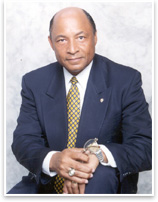 Clyde Porter, FAIA, Awarded 2009 Whitney M. Young Jr. Award Clyde Porter, FAIA, Awarded 2009 Whitney M. Young Jr. Award
by Zach Mortice
Associate Editor
Summary: Clyde Porter, FAIA, has been awarded the 2009 Whitney M. Young Jr. Award. The Dallas-based architect and facilities administrator was recognized for his work in extending educational and design opportunities to underserved and minority communities.
The AIA Board of Directors bestowed the Whitney M. Young Jr. Award to Clyde Porter, FAIA, on December 4 for encouraging minority, underserved, and low-income students to see themselves as architects and stewards of the built environment, and for extending the fruits of higher education to these same communities through his job with the largest undergraduate institution in the state of Texas. The Whitney Young Award is given annually to the architect or organization that best exemplifies the profession’s social responsibility to be a positive force of change. Porter will be presented with the award at the 2009 AIA national convention.
“Outta sight!” Porter said, reached by phone the day after he was given the award. “I’m speechless.”
A client and an advocate
The 1995 Whitney Young Award winner Bill Stanley, FAIA, spoke in support of Porter at the AIA Board’s December meeting, comparing him to last year’s winner, Norma Sklarek, FAIA, whose litany of firsts as an African-American and a female architect reach back across nearly half a century.
“Clyde is the same kind of individual from a different perspective,” he said. “He’s immersed himself in the community. He’s influenced tastes, and he’s practiced architecture in a somewhat nontraditional role.”
For 21 years, Porter has been at the Dallas County Community College District (DCCCD) overseeing its facilities, campus planning, and building efforts. As associate vice chancellor of facilities at DCCCD, Porter oversees $700 million worth of buildings that house and educate approximately 100,000 students on seven campuses—the largest undergraduate program in the state. This work has given him the opportunity to create education facilities that, as a relatively affordable community college, are often low-income and minority families’ first taste of post-secondary school success.
“It is clear that [Porter] has always charted a course that allowed room for those whose paths are fraught with obstacles, and our culture and profession are better for it,” wrote board member Jeff Potter, AIA, in his nomination letter for Porter.
Porter has done much more than help offer educational opportunities to disadvantaged communities. While at DCCCD (and at his previous job as chief architect of the Dallas Area Rapid Transit agency), Porter started initiatives to ensure that female- and minority-run architecture, engineering, and contracting firms were hired for greater proportions of work. Fifty percent of commissions by DCCCD have since gone to female- and minority-owned firms, proving that these drastically increased proportions of minority participation are possible in the building design and construction industry, and that good work results from them.
Populist spirit of inclusion
Porter is well respected as a client of architects, not just in his generous and populist spirit of inclusion, but also as a savvy planner and administrator. Major projects he’s commissioned for the DCCCD include the El Centro Student and Technology Center in Dallas, the North Lake College New Community Library in Irving, and Richland College’s Thunderduck Hall in Richardson.
“The support Clyde provides to practicing architects reinforces quality design and professional services beyond what is expected,” wrote 1982 Whitney Young Award winner John Chase, FAIA, in a recommendation letter.
“I help architects become better architects,” Porter said.
During his time with Dallas Area Rapid Transit, he became a strong advocate for urban communities and public infrastructure by working to establish a $2.9 billion light rail and mass transit system. Porter says he gained the design acumen required to be a rigorous and engaged architecture client during his time (earlier in his career) as a draftsman in private practice and with the Army Air Force Exchange Service, where he planned and designed military installations.
Opening doors
Porter, a cofounder of the Texas chapter of the National Organization of Minority Architects, has built a legacy of inviting emerging and minority architects into the profession beyond hiring them for work. At the DCCCD, he established an intern program, and he regularly recruits from his alma mater, Prairie View A&M University in Prairie View, Tex., a historically African-American university. As chair of AIA Dallas’ Minority Resources Committee, Porter also began a summer internship program for minority architects. He’s also made it a habit to reach out to children before they reach college and encourage them to envision themselves as architects. He regularly speaks at elementary and middle school career days, explaining the ways that architects can change and grow their own communities to minority and low-income kids.
“That’s where the rubber hits the road,” Porter says.
“[Porter] is a trailblazer who, in his capacity as an administrator and facilitator, has opened doors that were previously closed to minority professionals, minority students, and minority communities,” wrote Stanley in a recommendation letter.
Porter’s previous awards and honors include:
- A Citation of Honor from AIA Dallas
- A resolution from the Texas Legislature commending outstanding contribution in architecture
- A Man of Minority Business Development Award from Minority Business News for Dallas and Fort Worth.
|


 Clyde Porter, FAIA, Awarded 2009 Whitney M. Young Jr. Award
Clyde Porter, FAIA, Awarded 2009 Whitney M. Young Jr. Award